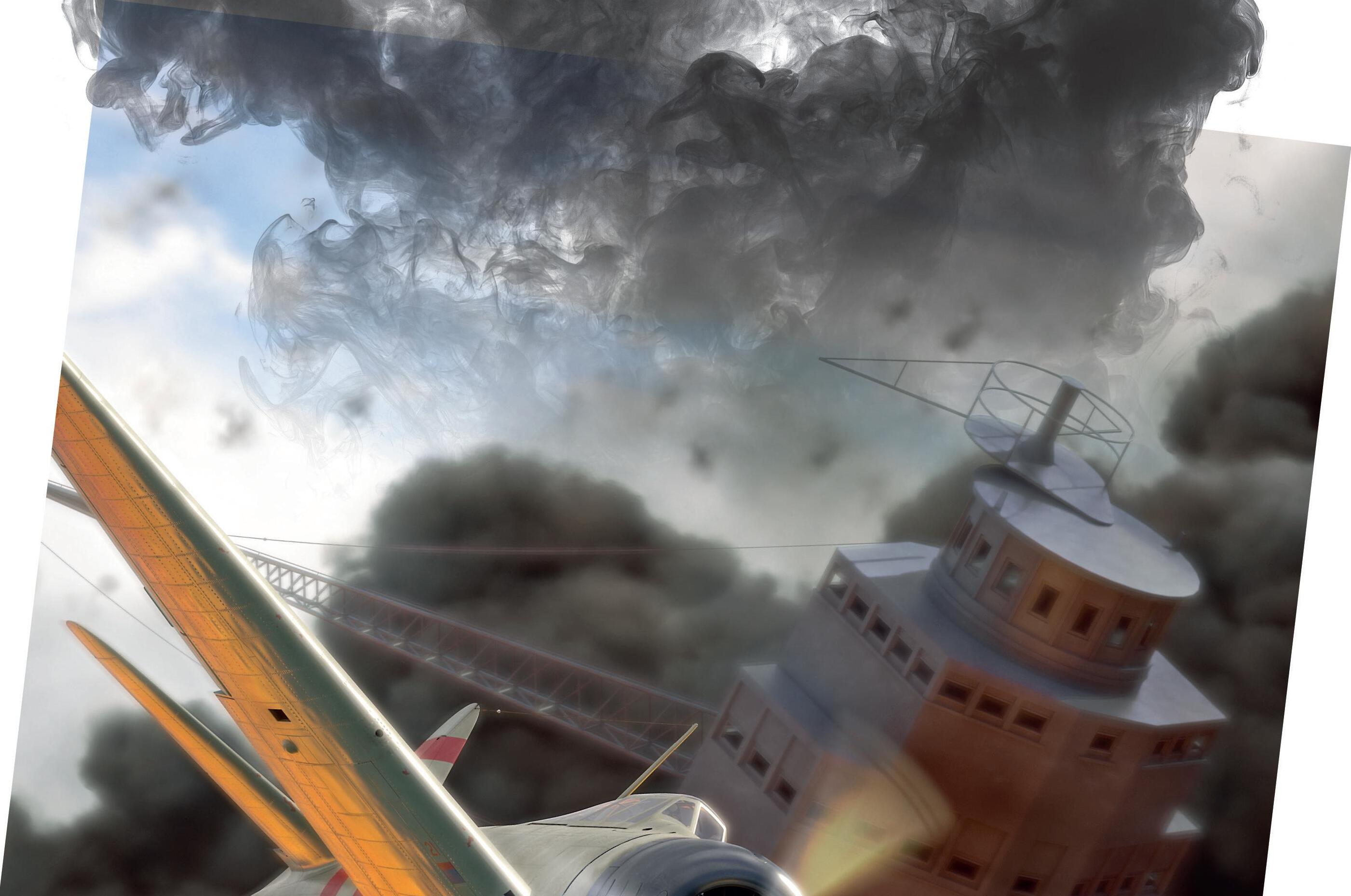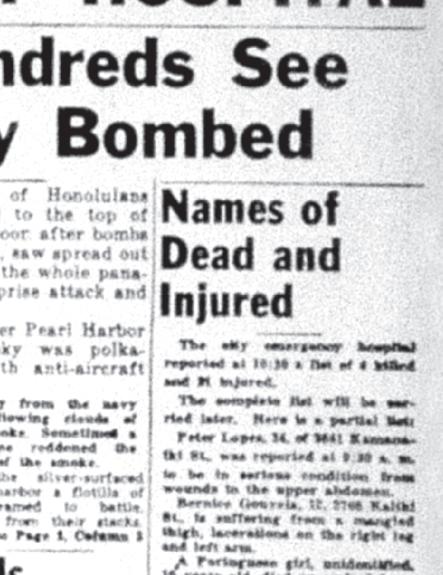








On Tuesday, December 7, 2021, America and the world will mark the 80th anniversary of the attack on Pearl Harbor with a series of commemorative events focused on those taking place in Hawaii.
In the time since the attack, the date has been honoured with various memorials and commemorations to pay tribute to those who were killed that Sunday, and more generally to the millions who lost their lives during the course of the Pacific War.

In the months after the Japanese offensive, ‘Remember December 7’ and ‘Remember Pearl Harbor’ became slogans used to incite hatred of the enemy and unite Americans behind the common cause of forcing unconditional Japanese defeat.
The words have stayed the same, but the sentiment has softened in the years since to a point where all those who perished and suffered as a result of that infamous Sunday are remembered.
Among those gathered on Oahu to pay their respects each year are those who witnessed it for themselves, coming together to honour fallen friends and colleagues; they being the only ones who can truly understand the horrors to which they were subjected.
Even as their numbers become fewer with each passing year, we must never forget these brave souls and the thousands more who never got the chance to share their harrowing story.
The story of Pearl Harbor is not an easy one to tell. Not only is it a gargantuan tale to try and weave into just 132 pages, but when delving into the facts the sobering realisation emerges that just 80 years ago a war was raging across the earth which would eventually claim the lives of more than 20 million of its inhabitants.
My interest in Pearl Harbor is historical, and that’s what I wanted this volume to be about, but remaining detached enough to present the cold hard facts has been a challenge –although it’s one I feel privileged to have been able to take on.
In my own small way, I’ve been able to remember the sacrifices that were made, the hardships which were endured and the incredible bravery and determination that ordinary people, no different to myself, were able to summon in the face of adversity.
I certainly hope my admiration and respect for all those who were involved on that ‘day of infamy’ and the wider conflicts of which it was a part are reflected in this volume, and that my efforts to present a fair and balanced narrative of what was occurring on both sides of the Pacific comes across.
In my own humble opinion, the Pearl Harbor attack is the single most defining episode of the last century, and we’re still trying to fully understand and learn the effects of it today. To say that I’d like you to ‘enjoy’ this read would seem strange given the topic, but I hope you find my presentation of Pearl Harbor history to be an interesting and informative one.
Jack Harrison AuthorI owe a great deal of thanks to a great many people and organisations for helping make this publication a reality. Professionally I must first praise the wealth of Pearl Harbor related resources which exist, allowing this fascinating and historically important tale to be told. More specifically to this volume, mentions must go to production editor Dan Sharp, designer Craig Lamb, cover artist Ronnie Olsthoorn, cover designer Justin Blackamore and picture desk operators Paul Fincham and Jonathan Schofield who used their collective expertise to hone my words and then bring them to life in the pages you see before you. On a final personal note I would like to express my appreciation for the support and understanding of friends, family and loved ones throughout the time it took to compile Pearl Harbor: The 80th Anniversary. It required a great deal of time, effort and concentration – not to mention a few late nights – to reach this final product and I would not have been able to achieve it without their help.
“Throughout the entire action, and through all the arduous labours which followed, there was never the slightest sign of faltering or of cowardice. The actions of the officers and men were all wholly commendable; their spirit was marvellous; there was no panic, no shirking nor flinching, and words fail in attempting to describe the truly magnificent display of courage, discipline, and devotion to duty of all officers and men.”
Pearl Harbor survivorThe wall of remembrance at the USS Arizona Memorial will be among the locations for commemorative events to mark the 80th anniversary of the Pearl Harbor attack. Courtesy, PA
A US military photographer surveys the devastation caused by the Japanese attack on Pearl Harbor as smoke rises into the skies above Battleship Row. Courtesy, PA

AUTHOR: Jack Harrison jharrison@mortons.co.uk
PAGE DESIGN: Craig Lamb design_lamb@btinternet.com
COVER DESIGN: Justin Blackamore
COVER ARTWORK: Ronnie Olsthoorn aviationart.aero
PRODUCTION EDITOR: Dan Sharp
PUBLISHER: Steve O’Hara
Images marked ✪ are in the public domain. Images marked ✱ are published under a Creative Commons License, creativecommons.org
PRINTED BY: Acorn Web, Normanton
ISBN: 978-1-911639-74-9
PUBLISHED BY:
Mortons Media Group Ltd, Media Centre, Morton Way Horncastle, Lincolnshire LN9 6JR Tel: 01507 529529
COPYRIGHT:
Mortons Media Group Ltd 2021 all rights reserved.































As the first of 353 Japanese aircraft broke through the clouds just a few miles off the coast of Oahu on the morning of December 7, 1941, it brought to an end America’s long-held policy of remaining officially neutral in the devastating war which was engulfing the world.
By the end of the offensive which ensued, the US had lost more than 2000 military personnel in a sneak attack, Japan was revelling in what it believed to be a great and decisive tactical victory – and neither could yet imagine the way in which the events of that fateful Sunday had already changed the world.
For America, torn between nearly 165 years of isolationism and a growing desire for a global role, the attack on Pearl Harbor sent a unifying wave across

the nation which now entered the conflict with an overwhelming vigour and sense of resolve. Westwards, across the Pacific, Japan followed its success in Hawaii with a dominant military campaign in South East Asia where it gained a significant early upper hand.
Soon, however, the US would begin a slow but decisive fight back which would result in several key victories, and culminate in the unleashing of the world’s first atomic weapons in Hiroshima and Nagasaki.
It’s through this historical context that I have attempted to tell the fascinating and often harrowing story of Pearl Harbor – not just what happened that day, but the complex set of circumstances which are inexorably linked to why it occurred, how it unfolded and the significant impact felt by both the belligerents involved and the wider world.

Today the world is accustomed to America being a far-reaching global superpower. Before the attack on Pearl Harbor however, and particularly before the First World War, the country’s political and military leaders had stood firmly behind a policy of isolationism…
Against the backdrop of Franklin D Roosevelt’s memorable speech to a joint session of Congress, the United States formally declared war on the Japanese Empire on December 8, 1941 – a direct response to the attack on Pearl Harbor.
Not yet 200 years old as a nation, America was now embroiled in the Second World War. It was no stranger to this kind of mass conflict however; in its relatively short history the US had endured the War of Independence, a civil war, involvement in the First World War and several confrontations with European and South American forces as it expanded and established its territory to the west coast and beyond throughout the 19th century.
Despite this familiarity with military engagements, it wasn’t until the attack on Pearl Harbor that the US embarked on a permanent outward-looking role in foreign affairs, instead of focusing its gaze on what was happening within its own borders, or just outside of them. The American tendency towards isolationism came, partly by design and partly by default, from the core ideals on which the nation was founded.
America’s pursuit of isolationism was never more evident than in 1919 when the Senate voted against joining the League of Nations which President Woodrow Wilson had helped to develop in the aftermath of the First World War. This cartoon – The Gap in the Bridge – appeared in Punch magazine on December 10 of that year and depicts the United States as the missing keystone of the League of Nations arch. Uncle Sam smoking a cigar symbolises American wealth. ✪
So monumental was the notion that a small band of revolutionaries could forge a new nation from a disparate collection of colonial territories, that turning the dream of America into a reality was the sole purpose of its founding fathers. The way in which the fledgling country would interact with the wider world was far from their immediate thoughts, but because the set of ideals and values they laid out in the Declaration of Independence of 1776 became so fundamental to every facet of the American existence, the desire for freedom soon became a strong tendency towards isolationism in its foreign policy.
It’s not hard to see how this concept developed. The declaration enshrines the right to ‘life, liberty and the pursuit of happiness,’ free from foreign interference or oppression, so it stands to reason that a country founded on that basic idea should not seek to extend its influence beyond its own peoples.
A far more compelling and practical reason why a role in foreign affairs wasn’t pursued in America’s infancy was that it simply didn’t have sufficient power or resources. And what measure it did have of each was devoted to its domestic goals, and then to ensuring its own survival once freedom had been achieved. This idea, that all efforts should be focused on advancement at home rather than interference abroad, would become so entrenched that nothing short of a direct assault on the American way of life could shake it.
The
This map depicting America in 1750, with modern day borders added for perspective, demonstrates the incredible challenge faced by the original 13 US colonies – the red British-owned territory – to establish a new nation. With a mass of French-owned land to the west, the Model Treaty and the Treaty of Alliance were both vital. Courtesy,

While America had neither the desire nor the realistic capability of being a player on a global scale at that time, its fortunes were nevertheless tied to those of its European contemporaries; in fact, its entire future depended on their actions.
By the time the Second Continental Congress had formed in 1775, the Revolutionary War was already under way and it was clear to the delegates of the colonies that they would require political,
economic and possibly military support from France.
As the de facto national government, the Continental Congress began negotiating with foreign nations on behalf of the colonies and dispatched delegate Silas Deane to France in 1776 to secure support for its independence campaign, the same year in which highly respected American diplomat Benjamin Franklin became the US ambassador to the country.

Later in the year, the Continental Congress would approve the Model Treaty with France, a document drafted by Massachusetts delegate and future president John Adams, which would become a template for subsequent international agreements. What makes it so signifi cant is that its primary focus was not to shape or dictate the course of general foreign affairs, but to ensure that the greatest possible number of commercial opportunities were available to the young nation, which had already spent vast sums of colonial cash in its fi ght against the British Empire.
The opportunity to prosper and make ful l use of its sought-after national resources was of paramount importance for the US and it began to lay that foundation by ensuring the Model Treaty had within its terms that America would accept no military personnel from France or submit to any French authority as part of any alliance. It was simply about the Continental Congress, and the governing bodies which would follow it, having the chance to present terms of trade.
It wasn’t until 1778 that France and America reached an agreement, and when they did it was not the Model Treaty but the Treaty of Alliance which was formally adopted. There were only slight differences to Adams’ original, but importantly these covered both nations not seeking territorial gains in areas that each had a claim on – the US in North America and France in the Caribbean. It also included a statement that the American colonies had no designs on Spanish territories.
With a formal alliance with France and support from Spain, the Revolutionary War turned in America’s favour as the 1770s came to a conclusion, and by the end of the decade and the beginning of the next, the Continental Congress was preparing peace terms which would see the British Empire recognise America as an independent nation. Foreign policy had been vital to the
imminent American victory, but although assistance had come from abroad its alliances were not the sort of complex agreements which would leave it vulnerable to either France or Spain asserting their own authority within the proposed American borders.
On September 3, 1783, the Treaty of Paris was signed by Great Britain and the United States of America to offi cially bring the Revolutionary War to an end.
In 1789 the fi rst US Congress would create the Department of Foreign Affairs, but this would soon be renamed the Department of State, as we know it today, and the symbolic change further demonstrated that America’s overseas concerns were about ensuring its own prosperity and not meddling in the business of others.

The new government’s commitment to this approach would be sternly tested in 1792 as Britain and France went to war and the French looked to the United States for backing, invoking the terms of the Treaty of Alliance. With his cabinet unanimously behind him, President George Washington declared neutrality and announced that the 1778 agreement no longer applied; the fi rst of three key events which would set a precedent for the American isolationism that would remain largely intact until 1941.
A fragile status quo had existed between the US and Great Britain in the decade since the end of the Revolutionary War, but the latter’s confl ict with France – or more importantly how America would react to it –saw tensions fl are once again. The second event that helped shape US foreign policy for the years to come was the signing of the Treaty of Amity, Commerce and Navigation, Between His Britannic Majesty and the United States of America; better known as the Jay Treaty.
After the US had gained its independence, Britain had become its most fruitful trading partner and neither country wanted to slip back into a costly and ruinous state of war. In order to avoid this, the Jay Treaty settled some of the questions concerning boundaries and trade that had lingered since the Treaty of Paris and, despite opposition from prominent members of the American government who still harboured strong anti-British sentiment, it was signed and is credited with averting an all-out war between the two nations, something America felt it simply could not afford at the time. By choosing the best course for American trade and commerce over international friendships or rivalries, Washington also set a foreign policy example which his predecessors had to follow. With the president’s actions having set out the stall for American isolationism, his words during his farewell address of 1796 cemented the policy in place.

He declared: “The great rule of conduct for us in regard to foreign nations is in extending our commercial relations, to have with them as little political connection as possible. So far as we have already formed engagements, let them be fulfi lled with
perfect good faith. Here let us stop. Europe has a set of primary interests which to us have none; or a very remote relation.”







By this time, Washington was a revered fi gure across America. He was the war hero who led 13 separate colonies to a victory against one of the largest and most powerful empires the world had ever seen, he was the political leader whose shrewd guidance had allowed a nation to establish itself and then he established his legacy by stepping down as president after eight years because he didn’t believe in one person holding power for longer. His words were as close to gospel as a non-religious fi gure could be, and they consecrated America’s isolationist stance as steadfast national policy.

Thomas Jefferson, America’s third president and the man considered to have had most influence on the Declaration of Independence, continued to develop Washington’s ideas during his time in office, stating in his own inaugural address in 1801 that the US should maintain ‘peace, commerce, and honest friendship with all nations, entangling alliances with none’.

Just 11 years later however, during the presidency of James Madison, America would once again find itself coming up against the British in the War of 1812. As has been the case with many, if not all, American military engagements in its entire history, the root cause was a threat to US trade.


While the three year conflict was costly, America was able to repulse British invasions of many key territories and retain its independence. The eventual outcome sparked a wave of nationalist sentiment too.
If the decisive actions and resounding words of political leaders had set out America’s foreign policy before then a perceived second victory against Great Britain sealed it once and for all; the US would not involve itself in foreign affairs unless it faced a direct threat or assault to its future.
As America developed, so did the world around it, particularly Latin America where many countries were facing their own battles to break the chains of European imperial rule. In response, President James Monroe delivered a speech to Congress in 1823 and its content would become a long-standing template for how US leaders approached world affairs.

The Monroe Doctrine, as it came to be known, put forward three main concepts: separate spheres of influence for the Americas and Europe, non-colonisation and non-interventionism. The aim was to

prevent the European powers from retaining dominion over Latin or South American states which wanted independence, or those which had already established self-rule, and while there was a publicised and probably genuine desire to see the American ideal of democracy spread across the continent, the driving force behind it was protecting US access to the new and emerging markets south of its borders.
Across the Atlantic, Britain showed some support for the move as it had a desire to see the demise of Spanish colonialism. In the months before the Monroe Doctrine, British Foreign Minister George Canning had suggested a joint statement which compelled other European powers to refrain from intervening in Central and South America but Secretary of State John Quincy Adams rejected this out of hand believing it to be tantamount to the kind of entangling alliance which Jefferson had warned against. Instead, Monroe’s address became a unilateral declaration that ‘the American continents… are henceforth not to be considered as subjects for future colonisation by European powers’.
In return, the US pledged to avoid political involvement in the affairs of Europe, Monroe explicitly stating: “In the wars of the European powers, in matters relating to themselves, we have never taken part, nor does it comport with our policy to do so. It is only when our rights are invaded, or seriously menaced that we resent injuries, or make preparations for our defence.” With the doctrine becoming such a cornerstone of American foreign policy, it was a promise that future presidents and governments would strive to keep, and only the most catastrophic of circumstances would force a change.
Less than 50 years after it resolutely declared its independence. America was now truly free as the European
A newspaper cartoon published in 1912 uses the iconic image of Uncle Sam to explain the Monroe Doctrine, showing the American continent in the Western Hemisphere separated from the rest of the world. ✪ KEY PLAYERS: Presidents Thomas Jefferson (left) and James Madison (right) played important roles in the direction of US foreign policy in the 19th century, continuing on the path set by Washington. ✪